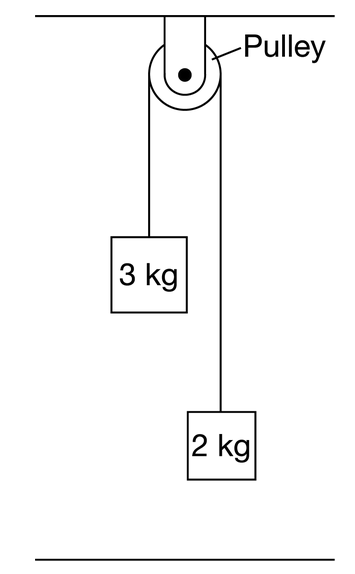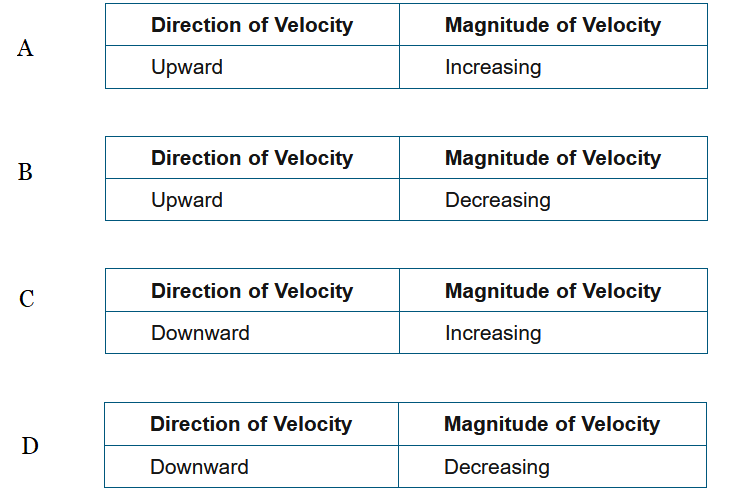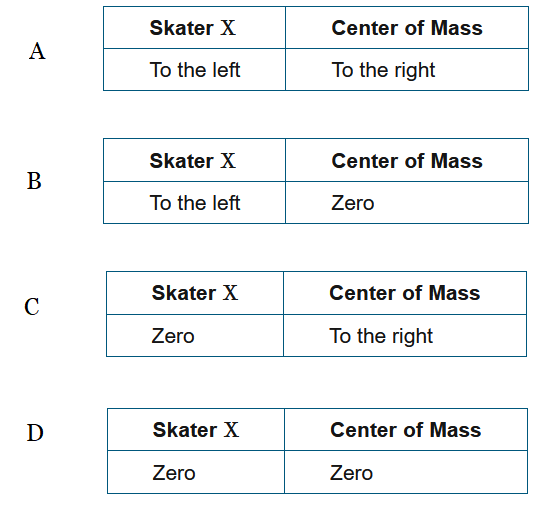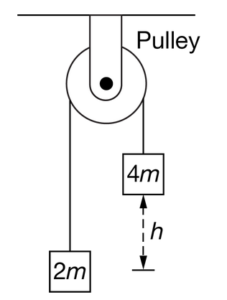Question
A \(12 \mathrm{~kg}\) box sliding on a horizontal floor has an initial speed of \(4.0 \mathrm{~m} / \mathrm{s}\). The coefficient of friction between the box and the floor is 0.20 . The box moves a distance of \(4.0 \mathrm{~m}\) in \(2.0 \mathrm{~s}\). The magnitude of the change in momentum of the box during this time is most nearly
(A) \(12 \mathrm{~kg} \cdot \mathrm{m} / \mathrm{s}\)
(B) \(48 \mathrm{~kg} \cdot \mathrm{m} / \mathrm{s}\)
(C) \(60 \mathrm{~kg} \cdot \mathrm{m} / \mathrm{s}\)
(D) \(96 \mathrm{~kg} \cdot \mathrm{m} / \mathrm{s}\)
▶️Answer/Explanation
Ans:B
Question

Two blocks of mass 2 kg and 3 kg are connected by a light string that passes over a pulley, as shown above. The pulley has negligible mass and friction. The two-block system is released from rest. Which of the following correctly describes the velocity of the two-block system’s center of mass?

▶️Answer/Explanation
Ans: C
There is a net force on the blocks, and since \(\vec{a}=\frac{\vec{F}_{net}}{m}\) the blocks accelerate at the same rate and move at the same speed, with the more massive block moving downward. This causes the center of mass to move downward with increasing speed
Question
Two ice skaters, Skater X and Skater Y, are at rest on a horizontal surface made of ice. The friction between the ice and the skaters is negligible. Skater X, who has a smaller mass than Skater Y, pushes Skater Y such that Skater Y travels with a speed of \(2v_o\) to the right. Which of the following indicates the direction of the velocity of Skater X and the direction of the velocity of the center of mass of the two-skater system after the push?

▶️Answer/Explanation
Ans:B
When Skater X exerts a force on Skater Y, Skater Y exerts a force equal in magnitude on Skater X such that Skater X moves to the left. The center of mass of the system will not move. There was no external force exerted on the system, and since \(\vec{a}=\frac{\vec{F}_{net}}{m}\) , the acceleration and thus the velocity of the center of mass is zero.
Question
An object of mass M is dropped near the surface of Earth such that the gravitational field provides a constant downward force on the object. Which of the following describes what happens to the center of mass of the object-Earth system as the object falls downward toward Earth?
A It moves toward the center of Earth.
B It moves toward the object.
C It does not move.
D The answer cannot be determined without knowing the mass of Earth and the distance between the object and Earth’s center.
▶️Answer/Explanation
Ans:C
There are no external forces exerted on the system. The only forces are the gravitational forces between the object and Earth, which are internal to the system. With no external forces exerted, the acceleration of the center of mass is zero.
Question

Three blocks are sliding together to the right along a surface of negligible friction when a force with magnitude \(F_{ext}\) is exerted to the left on the rightmost block, as shown in the figure. The masses of the blocks are indicated in the figure. If the force is exerted for a time Δt , what is the change in velocity of the center of mass of the three-block system?
A \(\frac{F_{ext}Δt}{6m}\)
B \(\frac{F_{ext}Δt}{2m}\)
C \(\frac{2F_{ext}Δt}{m}\)
D \(\frac{6F_{ext}Δt}{m}\)
▶️Answer/Explanation
Ans:A
Using Newton’s second law for the whole system \(F=ma=\frac{m_{sys}Δv_{com}}{Δt}\) \(∴Δv_{com}=\frac{FΔt}{m_{sys}}=\frac{F_{ext}Δt}{6m}\) .
Question

Block A of mass 4m is attached by a light string to block B of mass 2m. The string passes over a pulley with negligible friction and of negligible mass. Block A is held a distance h above the ground, as shown. The blocks are released from rest, and block A reaches the ground two seconds later. The value of h is most nearly
A \(13.3m\)
B \(6.7m\)
C \(3.3m\)
D \(2m\)
▶️Answer/Explanation
Ans:B
The net force on the system is 2mg and the mass of the system is 6m. So Newton’s second law of motion is \(2mg=6ma\). This gives \(a=(\frac{1}{3})g\). Substituting this a, \(v_0=0 m/s\), and \(t=2 s\) into the equation \(Δx=v_0t+(\frac{1}{2})at^2\) , gives \(Δx=(1/2)(1/3)(10)×2^2=(1/6)10×4=6.7 m\).
